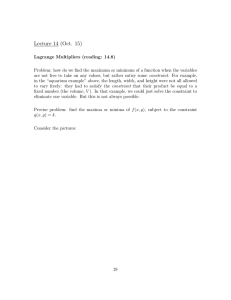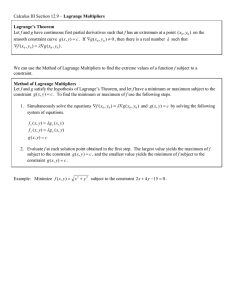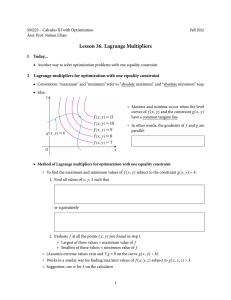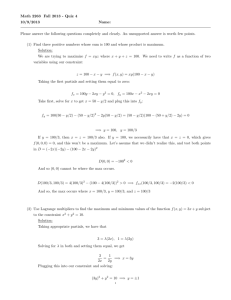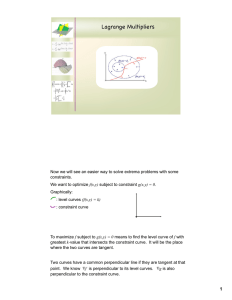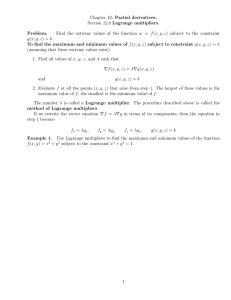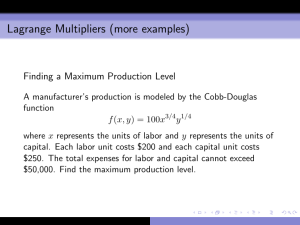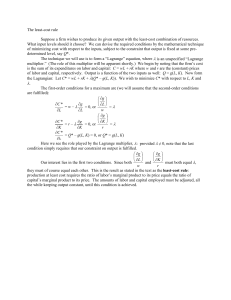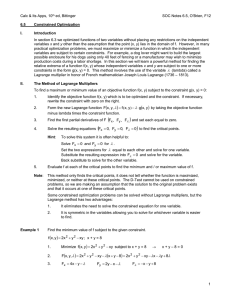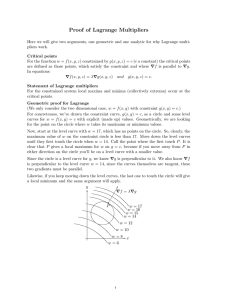Math 217 Assignment Solutions: Calculus Problems
advertisement
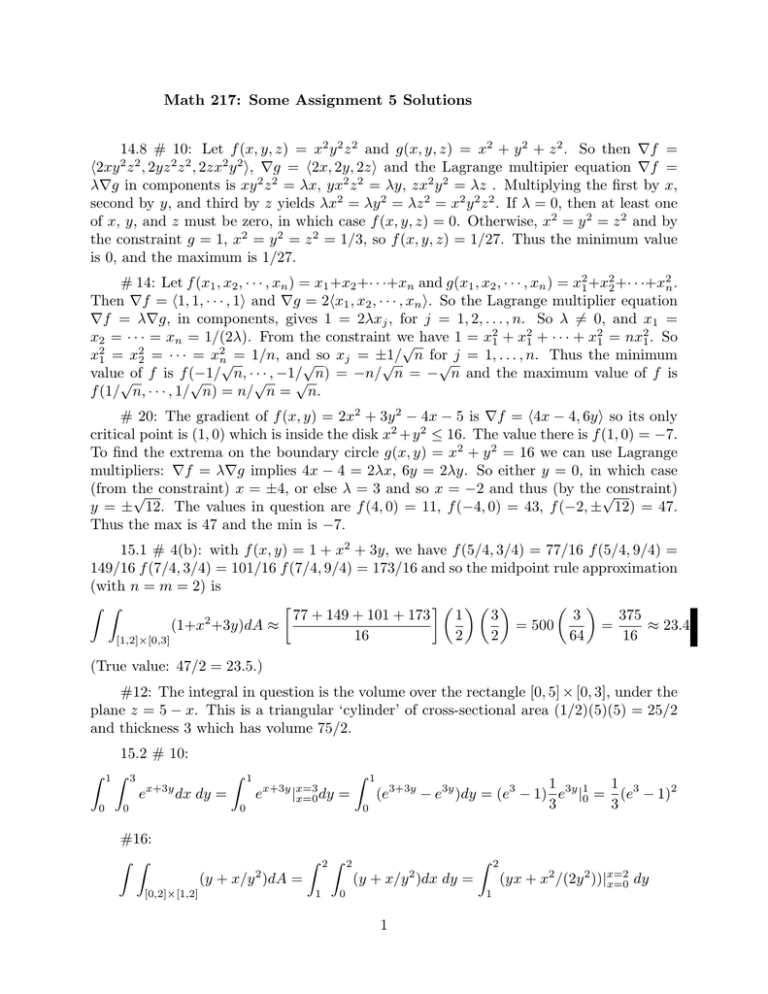
Math 217: Some Assignment 5 Solutions 14.8 # 10: Let f (x, y, z) = x2 y 2 z 2 and g(x, y, z) = x2 + y 2 + z 2 . So then ∇f = h2xy 2 z 2 , 2yz 2 z 2 , 2zx2 y 2 i, ∇g = h2x, 2y, 2zi and the Lagrange multipier equation ∇f = λ∇g in components is xy 2 z 2 = λx, yx2 z 2 = λy, zx2 y 2 = λz . Multiplying the first by x, second by y, and third by z yields λx2 = λy 2 = λz 2 = x2 y 2 z 2 . If λ = 0, then at least one of x, y, and z must be zero, in which case f (x, y, z) = 0. Otherwise, x2 = y 2 = z 2 and by the constraint g = 1, x2 = y 2 = z 2 = 1/3, so f (x, y, z) = 1/27. Thus the minimum value is 0, and the maximum is 1/27. # 14: Let f (x1 , x2 , · · · , xn ) = x1 +x2 +· · ·+xn and g(x1 , x2 , · · · , xn ) = x21 +x22 +· · ·+x2n . Then ∇f = h1, 1, · · · , 1i and ∇g = 2hx1 , x2 , · · · , xn i. So the Lagrange multiplier equation ∇f = λ∇g, in components, gives 1 = 2λxj , for j = 1, 2, . . . , n. So λ 6= 0, and x1 = 2 2 2 2 x2 = · · · = xn = 1/(2λ). From the constraint we √ have 1 = x1 + x1 + · · · + x1 = nx1 . So 2 2 2 x1 = x2 = · · · = xn√= 1/n, and √ so xj = ±1/ √ n for √ j = 1, . . . , n. Thus the minimum value√of f is f (−1/ n, ·√ · · , −1/√ n) = −n/ n = − n and the maximum value of f is √ f (1/ n, · · · , 1/ n) = n/ n = n. # 20: The gradient of f (x, y) = 2x2 + 3y 2 − 4x − 5 is ∇f = h4x − 4, 6yi so its only critical point is (1, 0) which is inside the disk x2 +y 2 ≤ 16. The value there is f (1, 0) = −7. To find the extrema on the boundary circle g(x, y) = x2 + y 2 = 16 we can use Lagrange multipliers: ∇f = λ∇g implies 4x − 4 = 2λx, 6y = 2λy. So either y = 0, in which case (from the constraint) √ constraint) x = ±4, or else λ = 3 and so x = −2 and thus (by the √ y = ± 12. The values in question are f (4, 0) = 11, f (−4, 0) = 43, f (−2, ± 12) = 47. Thus the max is 47 and the min is −7. 15.1 # 4(b): with f (x, y) = 1 + x2 + 3y, we have f (5/4, 3/4) = 77/16 f (5/4, 9/4) = 149/16 f (7/4, 3/4) = 101/16 f (7/4, 9/4) = 173/16 and so the midpoint rule approximation (with n = m = 2) is Z Z 77 + 149 + 101 + 173 1 3 3 375 2 (1+x +3y)dA ≈ = 500 = ≈ 23.4 16 2 2 64 16 [1,2]×[0,3] (True value: 47/2 = 23.5.) #12: The integral in question is the volume over the rectangle [0, 5] × [0, 3], under the plane z = 5 − x. This is a triangular ‘cylinder’ of cross-sectional area (1/2)(5)(5) = 25/2 and thickness 3 which has volume 75/2. 15.2 # 10: Z 1Z 3 Z x+3y e dx dy = 0 0 1 ex+3y |x=3 x=0 dy Z = 0 0 #16: Z Z 2 Z 2 Z (y + x/y )dA = [0,2]×[1,2] 1 1 1 (e3+3y − e3y )dy = (e3 − 1) e3y |10 = (e3 − 1)2 3 3 2 2 Z (y + x/y )dx dy = 1 0 1 1 2 (yx + x2 /(2y 2 ))|x=2 x=0 dy 2 Z (2y + 2/y 2 )dy = (y 2 − 2/y)|21 = 4 = 1 # 26: Z Z 2 Z 2 1 3 (3y − x + 2)dA = V = 2 (y − x y + Z 2y)|21 −1 [−1,1]×[1,2] 1 dx = (7 − x2 + 2) dx −1 = (9x − x3 /3)|1−1 = 52/3 # 36: the average value in question is 1 4 Z Z e [0,4]×[0,1] y √ x+ ey dA 1 = 4 Z 0 4 2 1 (x+ey )3/2 |y=1 y=0 dx = 3 6 Z 4 3/2 (x + e) − (x + 1) 0 1 12 5/2 5/2 4 5/2 5/2 5/2 (x + e) − (x + 1) |0 = (4 + e) − 5 − e + 1 = 65 15 Oct. 28 2 3/2 dx
